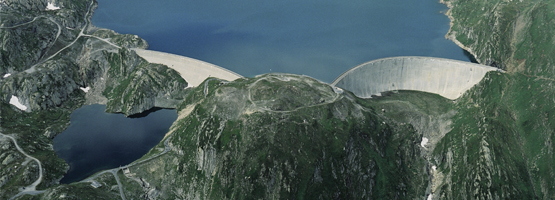Thanks to its topography and high levels of annual rainfall, Switzerland has ideal conditions for the utilisation of hydropower. Towards the end of the nineteenth century, hydropower underwent an initial period of expansion, and between 1945 and 1970 it experienced a genuine boom during which numerous new power plants were opened in the lowlands, together with large-scale storage plants.
Based on the estimated mean production level, hydropower still accounted for almost 90% of domestic electricity production at the beginning of the 1970s, but this figure fell to around 60% by 1985 following the commissioning of Switzerland's nuclear power plants, and is now around 57.6%. Hydropower therefore remains Switzerland's most important domestic source of renewable energy.
With the Energy Strategy 2050, the federal government aims to increase the average annual electricity production from hydropower to 38,600 gigawatt hours (GWh/a) by 2050 (37,400 GWh/a by 2035). In order to exploit the realizable potential, existing power plants must be modernized and expanded and new hydropower plants must be built, while always observing the principles of environmental protection. The federal government intends to utilize hydropower with various measures that are to be implemented as part of the first package of measures of the Energy Strategy 2050. The cost-covering feed-in remuneration for new hydropower plants with a capacity of up to 10 megawatts and the planned investments in the modernization and expansion of hydropower plants with a capacity of up to 10 megawatts are proving to be suitable instruments. In addition, various measures are planned to improve the framework conditions for hydropower (national interest, strategy for the expansion of renewable energies, simplification of approval procedures) as well as support measures as part of the SwissEnergy program.
The Swiss Federal Office of Energy deals with policy-related aspects of hydropower (promotion, strategies, perspectives) as well as technical and safety aspects, while the Swiss Federal Office for the Environment is responsible for environmental aspects (residual water, protection of bodies of water).






